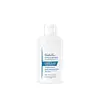What's inside
What's inside
 Key Ingredients
Key Ingredients

No key ingredients
 Benefits
Benefits

No benefits
 Concerns
Concerns

 Ingredients Side-by-side
Ingredients Side-by-side

Water
Skin ConditioningSodium Lauryl Sulfoacetate
CleansingDisodium Laureth Sulfosuccinate
CleansingSodium Lauroyl Sarcosinate
CleansingCocamidopropyl Hydroxysultaine
CleansingCocamidopropylamine Oxide
CleansingSodium Cocoyl Isethionate
CleansingPEG-150 Distearate
EmulsifyingDi-PPG-2 Myreth-10 Adipate
EmollientCocamide Mea
EmulsifyingGlycol Distearate
EmollientPolysorbate 20
EmulsifyingCaffeine
Skin ConditioningCinnamidopropyltrimonium Chloride
Glycerin
HumectantAmodimethicone
C11-15 Pareth-7
EmulsifyingLaureth-9
EmulsifyingTrideceth-12
EmulsifyingHydrolyzed Wheat Protein
Skin ConditioningCaprylyl Glycol
EmollientPhenoxyethanol
PreservativeWheat Amino Acids
Skin ConditioningHydrolyzed Soy Protein
HumectantDimethyl Sulfone
SolventPolyquaternium-10
Taurine
BufferingAspalathus Linearis Extract
Skin ConditioningParfum
MaskingBenzyl Benzoate
AntimicrobialBenzyl Cinnamate
PerfumingTetrasodium EDTA
Citronellol
PerfumingHexyl Cinnamal
PerfumingLinalool
PerfumingCI 15985
Cosmetic ColorantBiotin
AntiseborrhoeicCalcium Pantothenate
Alcohol Denat. Sd Alcohol 40
SolventTocopherol
AntioxidantAesculus Hippocastanum Seed Extract
Skin ConditioningRetinyl Palmitate
Skin ConditioningLinoleic Acid
CleansingPEG-35 Castor Oil
EmulsifyingInositol
HumectantCopper Tripeptide-1
Skin ConditioningCI 14700
Cosmetic ColorantPolyquaternium-11
Arginine
MaskingPEG-12 Dimethicone
Skin ConditioningPanax Ginseng Root Extract
EmollientAcetyl Tyrosine
Skin ConditioningArctium Majus Root Extract
Skin ConditioningEthylbisiminomethylguaiacol Manganese Chloride
AntioxidantNiacinamide
SmoothingOrnithine Hcl
Skin ConditioningZinc Gluconate
Skin ConditioningCitrulline
Skin ConditioningGlucosamine Hcl
Hydrolyzed Proanthocyanidin
AntioxidantCitric Acid
BufferingWater, Sodium Lauryl Sulfoacetate, Disodium Laureth Sulfosuccinate, Sodium Lauroyl Sarcosinate, Cocamidopropyl Hydroxysultaine, Cocamidopropylamine Oxide, Sodium Cocoyl Isethionate, PEG-150 Distearate, Di-PPG-2 Myreth-10 Adipate, Cocamide Mea, Glycol Distearate, Polysorbate 20, Caffeine, Cinnamidopropyltrimonium Chloride, Glycerin, Amodimethicone, C11-15 Pareth-7, Laureth-9, Trideceth-12, Hydrolyzed Wheat Protein, Caprylyl Glycol, Phenoxyethanol, Wheat Amino Acids, Hydrolyzed Soy Protein, Dimethyl Sulfone, Polyquaternium-10, Taurine, Aspalathus Linearis Extract, Parfum, Benzyl Benzoate, Benzyl Cinnamate, Tetrasodium EDTA, Citronellol, Hexyl Cinnamal, Linalool, CI 15985, Biotin, Calcium Pantothenate, Alcohol Denat. Sd Alcohol 40, Tocopherol, Aesculus Hippocastanum Seed Extract, Retinyl Palmitate, Linoleic Acid, PEG-35 Castor Oil, Inositol, Copper Tripeptide-1, CI 14700, Polyquaternium-11, Arginine, PEG-12 Dimethicone, Panax Ginseng Root Extract, Acetyl Tyrosine, Arctium Majus Root Extract, Ethylbisiminomethylguaiacol Manganese Chloride, Niacinamide, Ornithine Hcl, Zinc Gluconate, Citrulline, Glucosamine Hcl, Hydrolyzed Proanthocyanidin, Citric Acid
Ingredients Explained
These ingredients are found in both products.
Ingredients higher up in an ingredient list are typically present in a larger amount.
Citric Acid is an alpha hydroxy acid (AHA) naturally found in citrus fruits like oranges, lemons, and limes.
Like other AHAs, citric acid can exfoliate skin by breaking down the bonds that hold dead skin cells together. This helps reveal smoother and brighter skin underneath.
However, this exfoliating effect only happens at high concentrations (20%) which can be hard to find in cosmetic products.
Due to this, citric acid is usually included in small amounts as a pH adjuster. This helps keep products slightly more acidic and compatible with skin's natural pH.
In skincare formulas, citric acid can:
While it can provide some skin benefits, research shows lactic acid and glycolic acid are generally more effective and less irritating exfoliants.
Most citric acid used in skincare today is made by fermenting sugars (usually from molasses). This synthetic version is identical to the natural citrus form but easier to stabilize and use in formulations.
Read more about some other popular AHA's here:
Learn more about Citric AcidParfum is a catch-all term for an ingredient or more that is used to give a scent to products.
Also called "fragrance", this ingredient can be a blend of hundreds of chemicals or plant oils. This means every product with "fragrance" or "parfum" in the ingredients list is a different mixture.
For instance, Habanolide is a proprietary trade name for a specific aroma chemical. When used as a fragrance ingredient in cosmetics, most aroma chemicals fall under the broad labeling category of “FRAGRANCE” or “PARFUM” according to EU and US regulations.
The term 'parfum' or 'fragrance' is not regulated in many countries. In many cases, it is up to the brand to define this term.
For instance, many brands choose to label themselves as "fragrance-free" because they are not using synthetic fragrances. However, their products may still contain ingredients such as essential oils that are considered a fragrance by INCI standards.
One example is Calendula flower extract. Calendula is an essential oil that still imparts a scent or 'fragrance'.
Depending on the blend, the ingredients in the mixture can cause allergies and sensitivities on the skin. Some ingredients that are known EU allergens include linalool and citronellol.
Parfum can also be used to mask or cover an unpleasant scent.
The bottom line is: not all fragrances/parfum/ingredients are created equally. If you are worried about fragrances, we recommend taking a closer look at an ingredient. And of course, we always recommend speaking with a professional.
Learn more about ParfumPolyquaternium-10 is an ammonium salt of hydroxyethylcellulose. It is a white and granular powder used as a film-former and anti-static agent.
This ingredient is commonly found in hair conditioning products. According to a manufacturer, its positive charge makes it great for absorbing hair proteins. The manufacturer also states this ingredient helps with curl retention.
For haircare friends: this ingredient is not a silicone.
Learn more about Polyquaternium-10Water. It's the most common cosmetic ingredient of all. You'll usually see it at the top of ingredient lists, meaning that it makes up the largest part of the product.
So why is it so popular? Water most often acts as a solvent - this means that it helps dissolve other ingredients into the formulation.
You'll also recognize water as that liquid we all need to stay alive. If you see this, drink a glass of water. Stay hydrated!
Learn more about Water